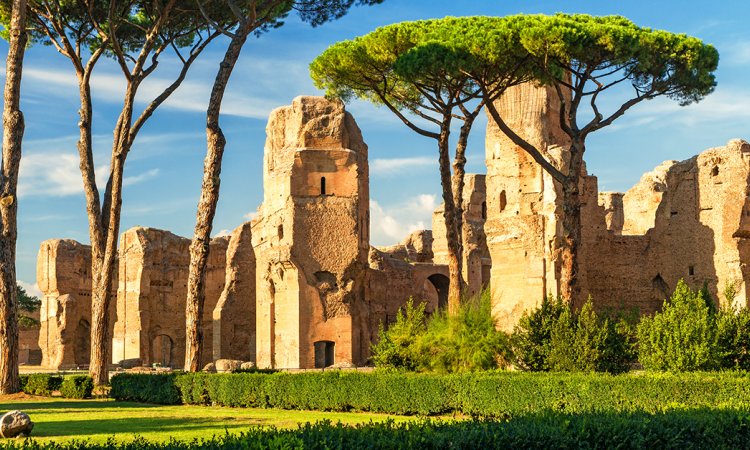
After a long train ride, say from Rome to Genoa, you might want to jump in the shower to freshen up. But private showers weren't the norm in ancient Rome. About 1,500 years ago you couldn’t throw a rock in Rome without hitting a public bathhouse. Since the third century BCE, when Romans borrowed the idea of the public bathhouse and the concept of the regular bathing ritual from the Greeks, Rome has refined the art of not just bathing, but relaxation itself.
Bathhouses in Rome
The custom of bathing regularly by immersing one’s entire body on an almost daily basis didn’t make it to Rome until around 300 BCE. Before then, most Romans gave their arms and legs a quick once over but bathed their entire bodies every ten days or so, either in lavatrine (washrooms near their kitchens) or in the Tiber River.
Modern bathers won’t be surprised to find that hot baths caught on pretty quickly in Rome. Engineers and architects of the ancient world par excellence, the Romans developed extensive aqueducts to get the water where it needed to be and built systems for heating both water and interior spaces.
Roman bathing complexes featured hot and cold rooms and pools, as well as other spaces for massage, reclining, socializing, and dining. Emperors had their own extravagant bathing complexes, which included masterful mosaics, some of which are still at least partially intact. Portions of the terme of the Emperors Diocletian, Caracalla, and Trajan, for instance, are currently open for tourism and definitely worth a visit.
Best Roman baths in Rome
Today, Rome boasts a variety of luxurious relaxation facilities that have their roots in the bathing rituals of yore. The emphasis of the terme (bathing complexes) and spas is, of course, water. And water is delivered in a number of surprising ways — from high-pressure showers and vigorous whirlpools, pools of revitalizing cold water, pore-opening, muscle-relaxing steam rooms, fragrant herbal floats that soothe multiple senses, and thermal spring waters mixed with volcanic mud.
Choose a hammam, a middle-eastern take on the bathhouse model, or go with the familiar international bathhouse with saunas, showers, jacuzzis, steam rooms, and the like. If natural hot springs are your preference, you can find them a short distance outside the city.
From traditional to contemporary, here are three spas you can visit in or near Rome today:
QC Terme, Fiumicino district
For a thoroughly Roman bathing experience rooted in contemporary health and wellness knowledge, try the incomparable QC Terme in Rome’s Fiumicino district. Guests wind their way through tastefully restored ancient buildings to a beautifully curated garden, biosaunas, steam baths, whirlpools, and regenerating waterfalls. This large spa complex also provides relaxation areas after you’ve completed your treatments, allowing you to sit quietly in a peaceful reading room or commune with friends in tranquil surroundings. Reservations are required and package deals are the way to go.
Aqua Madre, Jewish Ghetto
If your preference is for the traditional hammam experience, you’ll appreciate Aqua Madre, which has combined hammam bathing and relaxation customs with the sedate architectural ambience of ancient Rome. Featuring the signature, narrow, terracotta bricks and graceful arches of many old Roman interiors, this chic spot is located in the Jewish Ghetto and posh gallery district, a ten-minute walk from the Ponte Fabricio pedestrian bridge. With the traditional terme areas — frigidarium (cold room), tepidarium (warm room), and caldarium (hot room) — Aqua Madre offers a variety of services, including the traditional hammam soaps and oils, full-body scrub and massage, and so forth. Reservations are required.
Terme dei Papi, Viterbo
A quick train ride or drive will take you out of Rome for the day to the city of Viterbo and the Terme dei Papi, (Baths of the Popes).
Combine history, nature, and luxury as you explore Viterbo, an incomparably beautiful, ancient city with its marvelous medieval district, peppering of fascinating historic monuments, and its array of architecture from different golden ages. Spend your morning touring and then dedicate your afternoon to the Terme dei Papi: baths, spa, hotel, and restaurant in one tastefully appointed complex.
Once known as the Terme Etrusche (the “Etruscan Baths”), the Romans recognized the beauty and power of the city and its thermal springs. Remains of different Roman baths have been discovered over the years along a seven-mile stretch of the Via Cassia, an ancient road that runs between Rome and Tuscany. The baths were all in the proximity of three major thermal springs, including the Bullicame Spring, the center of the Terme dei Papi.
The popes picked up where ancient Romans left off, creating luxurious complexes. Pope Boniface IX claimed the thermal waters and mud had cured his “terrible aches of the bones.”
Recommended by the likes of Dante and Michelangelo, this thermal bath and spa complex is the real deal, as they say. The waters of the most famous of the thermal springs at the Terme dei Papi, the Bullicame Spring, contain a variety of minerals, including magnesium, at a temperature between 40° and 58° C (104° to 127° F). This particular spring feeds a stunning 6,000 square foot pool. The Terme dei Papi also offers a volcanic pool, which combines the lavic clay bed of the pool and the thermal waters.
Perfecting the ancient art of bathing
As a major world capital with a reputation for appreciating luxury, Rome’s spa and bath offerings are extensive. For a more authentic experience when in Rome, we think the ancients got it right and the moderns have simply refined the art of bathing. Your mission: look for a bathhouse or spa that really captures the essence of the city and the ancient roots of the bathing ritual.
What are you waiting for? Book your tickets now!


